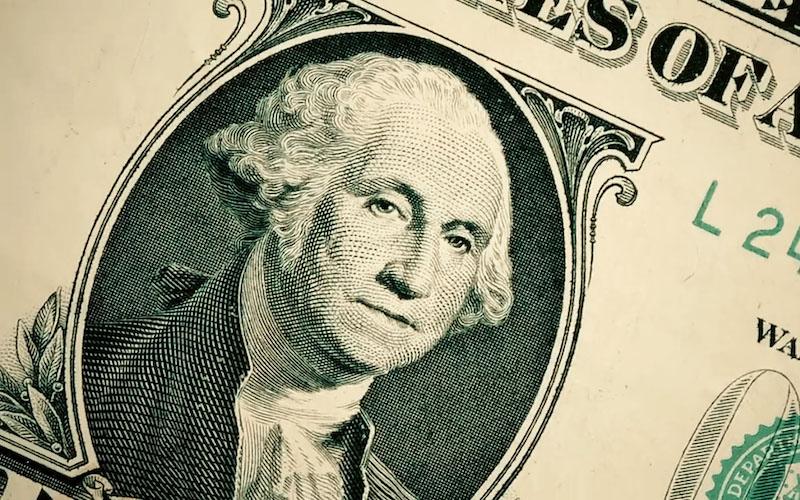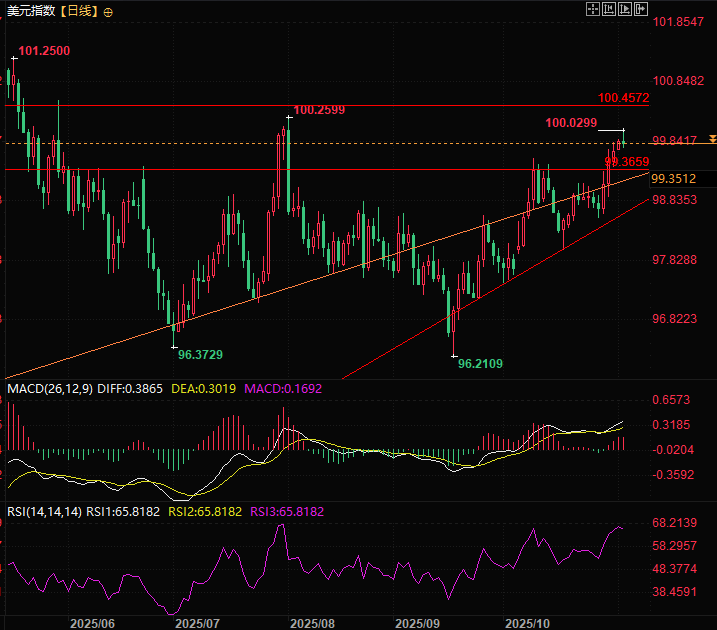The dollar regained and then lost the 100-point mark before the ADP non-farm payrolls report. What secrets lie hidden beneath the Fed's "hawkish and dovish" stance?
2025-11-04 16:14:07
The current fluctuations in the US dollar index are revolving around expectations of Federal Reserve policy, changes in US Treasury yields, and domestic risk events in the United States. The interplay between bullish and bearish forces keeps market sentiment cautious.

The Fed's cautious expectations and US Treasury yields boosted the dollar.
The core driver of the dollar index’s rise stems from the Federal Reserve’s cautious shift in policy outlook.
According to data from the CME FedWatch Tool, current federal funds futures traders are pricing in a 65% probability of a December rate cut by the Federal Reserve, a significant drop from 94% a week ago.
The direct trigger for this change in probability was the statement made by Federal Reserve Chairman Jerome Powell at the post-meeting press conference last week. He clearly pointed out that the possibility of another rate cut in December was far from certain, and emphasized that policymakers should maintain a "wait-and-see" attitude until official data releases resume.
Continued volatility in 10-year US Treasury yields supports a stronger dollar.
On Monday, the yield on the 10-year U.S. Treasury note rose by 2.7 basis points, further strengthening the dollar's interest rate advantage. This, coupled with Powell's warning that a December rate cut is not a given, provided continued momentum for the dollar index's rise.
It is worth noting that the yield on the 10-year US Treasury bond surged by 10 basis points on October 29, which was also the starting date of the current continuous rise in the US dollar index.

(Daily chart of the yield on 10-year US Treasury bonds)
Divergent statements from Federal Reserve officials may cause the dollar index to fluctuate.
Policy disagreements within the Federal Reserve have further increased the uncertainty surrounding the dollar index. Current officials' views can be divided into clearly dovish and slightly hawkish camps, and a unified direction has not yet been reached.
Among them, the dovish Federal Reserve Governor Stephen Milan stated clearly on Monday that "the current Fed policy stance is overly tight, and the neutral interest rate is far below the current policy rate."
He further added, "Given that my assessment of inflation is more optimistic than that of other members of the committee, I see no need to maintain the current tight monetary policy." It is worth noting that Milan had previously taken leave from the White House Council of Economic Advisers and is currently serving as an interim member of the Federal Reserve Board of Governors.
Another Federal Reserve governor, Lisa Cook, also holds a dovish stance, noting that "the risk of further weakening in the labor market outweighs the risk of a rebound in inflation."
However, neither of them explicitly committed to supporting an interest rate cut at the December Federal Open Market Committee (FOMC) meeting, only emphasizing that the monetary policy path is not predetermined.
Unlike the doves, Chicago Fed President Austan Goolsby expressed a more hawkish view.
He stated that he is more concerned about inflation than the job market, but has not yet determined the policy stance for the December FOMC meeting. Goolsby also mentioned that "there is still considerable room for interest rates to be lowered, but the pace of reduction will likely need to be consistent with the pace of inflation decline," hinting at a cautious attitude towards rate cuts.
The US dollar index faces challenges from government shutdown and weak economic data.
Despite the short-term strength of the US dollar index, its upside potential still faces two key limiting factors.
One issue is the ongoing deadlock in the US government shutdown, which has now entered its sixth week. Congress is deadlocked on a Republican-backed appropriations bill, with no signs of a breakthrough in the short term.
More importantly, the continued unpaid work of federal employees across the United States has not only exacerbated the uncertainty of the economic outlook but also fueled market caution, indirectly putting downward pressure on the US dollar.
Secondly, there are weak economic data signals. The Institute for Supply Management (ISM) reported that the October manufacturing Purchasing Managers' Index (PMI) fell to 48.7 from 49.1. This data not only shows that the contraction in the manufacturing sector was greater than expected, but also reflects a simultaneous cooling of price pressures. Furthermore, it was significantly lower than the market expectation of 49.5, further weakening the fundamental support for the US dollar.
However, it is worth noting that the preliminary reading of the US October SPGI Manufacturing PMI at 52.2 slightly exceeded expectations, while the final reading released yesterday was 52.5, which was slightly revised upward. This data mainly includes 1,400 companies in the US, unlike the ISM PMI which includes US multinational companies. Therefore, it seems that the domestic situation in the US is still acceptable, but the external business conditions have deteriorated.
Going forward focus: Key economic data will guide short-term direction.
The data to be released later will be an important guide for the short-term trend of the US dollar index.
Due to the continued US government shutdown, the September factory orders data released by the US Census Bureau and the JOLTS job openings data released by the US Department of Labor may both be unavailable.
The market is currently focused on Wednesday's US October ADP employment change, commonly known as the US non-farm payroll data.
Overall, the US dollar index is currently in a state of "coexistence of support and resistance, and a game between policy and data." Its future trend will depend on the linkage between the Fed's statements and economic data.
Technical Analysis:
As can be seen from the daily chart of the US dollar index, after breaking through 99.36, the US dollar index has continued to hold at this price level. The measured increase after the breakthrough is around 100.45. Currently, the psychological level of 100 is the first resistance level, followed by the measured increase level of 100.45.
The US dollar index has support at 99.36, as well as the red upward trend line in the chart.

(US Dollar Index Daily Chart, Source: FX678)
At 16:05 Beijing time, the US dollar index is currently at 99.80.
- Risk Warning and Disclaimer
- The market involves risk, and trading may not be suitable for all investors. This article is for reference only and does not constitute personal investment advice, nor does it take into account certain users’ specific investment objectives, financial situation, or other needs. Any investment decisions made based on this information are at your own risk.





















